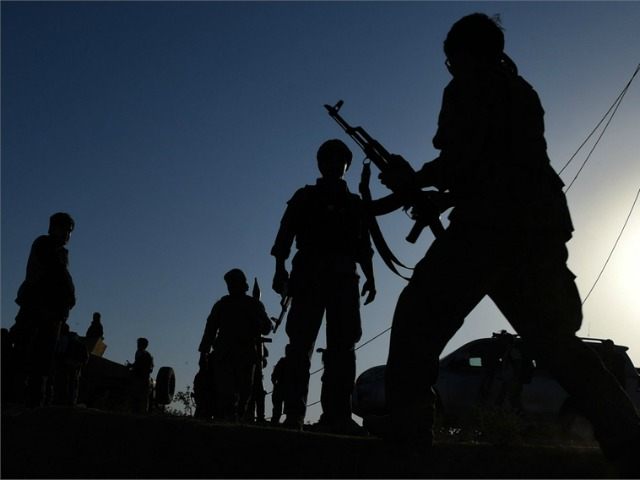An estimated 50,000 militants are operating in Afghanistan, the bulk of whom are Taliban terrorists, but there is also a rival 2,000 to 3,000-strong Islamic State (ISIS/ISIL) presence that continues to grow, according to the Russian General staff chief.
The Taliban in Afghanistan has assembled “special forces,” dubbed “Reserve Units,” to take on rival ISIS, notes Khaama Press, citing a BBC report.
BBC reportedly learned from unnamed “informed sources” that the so-called Taliban “special forces” are made up of young people who are being trained to specifically focus on fighting Daesh, an acronym based on ISIS’s original name in Arabic.
The BBC report “further states that the new force has been provided more equipment than other Taliban fighters,” states Khaama Press.
Taliban spokesman Zabihullah Mujahid reportedly confirmed the existence of the new Taliban force.
“Currently there are up to 50,000 fighters in Afghanistan, united in over 4,000 units and groups of various kinds,” said Russian General Staff chief Gen. Valery Gerasimov last Thursday at an international forum on Afghanistan organized by the Russian Defense Ministry, reports the TASS Russian news agency. “Their basis is the Islamic movement of the Taliban numbering about 40,000 militants,” Gerasimov said.
“According to our estimates, there are from 2,000 to 3,000 Islamic State militants in Afghanistan, and their number is constantly growing,” he added, according to Sputnik news.
Citing Russian intelligence during the forum, Zamir Kabulov, Russian President Vladimir Putin’s special envoy for Afghanistan, provided a higher estimate for the number of ISIS jihadists in Afghanistan–3,500–a number that he said continues to grow, reports Russia Today (RT).
“The rise of [ISIS] in Afghanistan is a high-priority threat. Just think about it: [ISIS] showed up in Afghanistan for real just a year ago, and now it has 3,500 fighters plus supporters who may be recruited into the ranks of the militants,” he said.
Kabulov claimed that Americans, Britons, Arabs, and Pakistanis are among the instructors who are training people from Central Asia and Russia at the “several” ISIS operated camps in Afghanistan.
Russia is reportedly helping to strengthen the U.S.-trained Afghan National Defense and Security Forces (ANDSF), which have struggled to fend off a strong and aggressive Taliban resurgence since President Obama ended America’s combat mission in Afghanistan in December 2014 and withdrew most U.S. troops.
“Russia is already providing certain assistance in strengthening the capabilities of the Afghan government forces,” which includes army, police, and militia units, said Kabulov, according to Khaama Press citing Russian local media.
Kabulov revealed that Putin has ordered Moscow to deliver Mi-35 gunship helicopters to Afghanistan, which has reportedly requested military assistance from Russia.
Afghanistan and Moscow are expected to sign an agreement for the delivery this month.
Kabul reportedly conceded that Moscow is already delivering weapons and providing military training to Afghanistan.
In April, Shakir Kargar, Afghan President Mohammad Ashraf Ghani’s special representative for the Commonwealth of Independent States (CIS), predicted that negotiations between Kabul and Moscow regarding the purchase of Mi-35 helicopters would begin soon.
“In the meantime, the First Vice President [of Afghanistan], Gen. Abdul Rashid Dostum has requested Moscow to provide military assistance to the Afghan security forces during his visit to Russia,” notes Khaama Press.
U.S. Gen. John F. Campbell warned American lawmakers last week against Russia filling in the security vacuum that would arise if the United States withdraws from Afghanistan.
“If we’re not there to provide influence, somebody else is going to be there, whether it’s Russia, China, Iran–you name it,” he told the House Armed Services Committee last Thursday.
Training and equipping the Afghan forces have cost American taxpayers an excess of $60 billion since the United States invaded Afghanistan in October 2001.
Afghan Air Force officials have reportedly complained that the first six Armed MD-530 helicopters they received under the ongoing U.S./NATO-led train, assist, and advise mission “have proved to be insufficient to meet their demands considering the mountainous terrain of Afghanistan and the effective range of the helicopters.”
Khaama Press notes:
Col. Qalandar Shah Qalandari of the Afghan Air Force said the helicopters cannot even reach areas where the Taliban normally operate and in summertime, the maximum altitude of the helicopters with a full load of fuel and ammunition is only 7,000 to 8,000 feet–meaning it cannot cross most of the mountain ranges that encircle Kabul, which is itself at an elevation of about 6,000 feet.
“It’s unsafe to fly, the engine is too weak, the tail rotor is defective and it’s not armored. If we go down after the enemy we’re going to have enemy return fire, which we can’t survive. If we go up higher, we can’t visually target the enemy,” said the Afghan colonel Qalandari, according to The New York Times. “Even the guns are no good.”
U.S. troops in Afghanistan were expected to draw down to a small embassy by the end 2016. However, given the deteriorating security situation, Gen. Campbell and other U.S. military officials have suggested extending the American military presence for “years” beyond 2016.

COMMENTS
Please let us know if you're having issues with commenting.